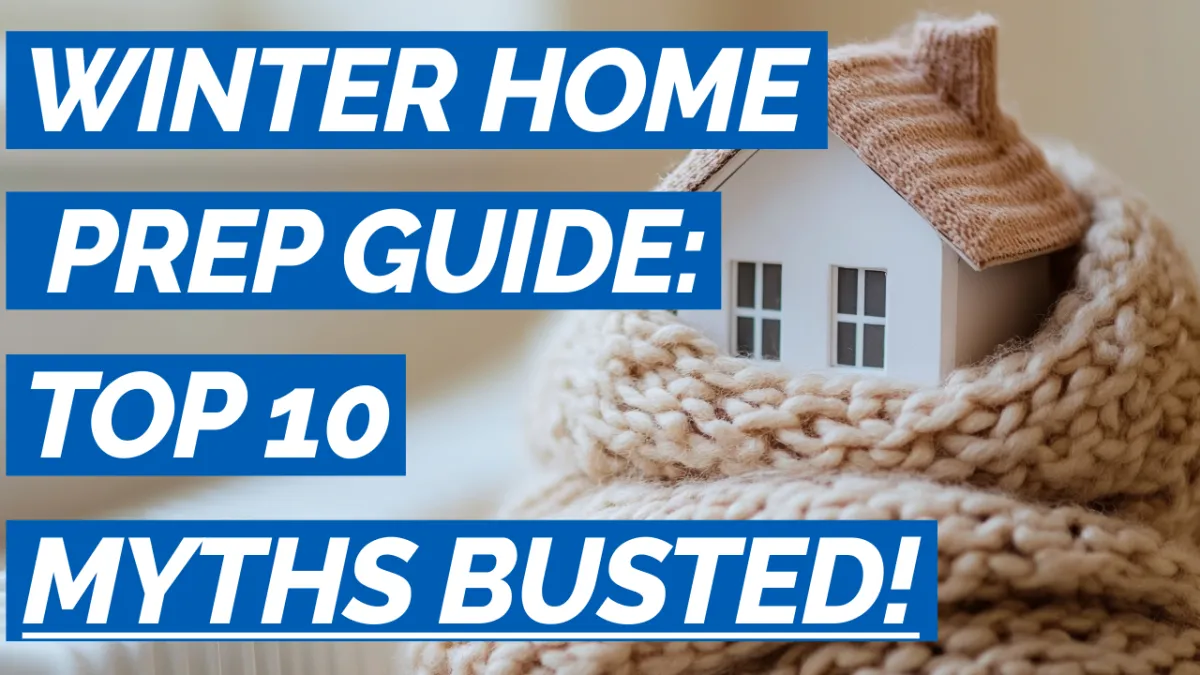
Winter Home Prep Guide: Top 10 Myths Busted!
Most winter home maintenance tips you see repeat the same old advice: add insulation to your attic, weatherstrip doors, or put plastic over your windows.
The problem?
Those tips often waste time and money, and the improvements don’t actually solve home comfort issues!
This top ten list busts common myths and gives you the proven building-science advice that actually works to keep your home comfortable, healthy, and efficient all winter long.
1. Air Seal Your Attic First — Don’t Just Add Insulation!
Myth: “If I dump a bunch of insulation in my attic then my house will be comfortable.”
Truth: Insulation slows heat loss, but if you don’t seal the air leaks first, that expensive insulation won’t work as intended.
Seal gaps around attic hatches, electric/plumbing/HVAC penetrations, recessed lights, exhaust fans, junction boxes, and where wall top plates meet drywall before you blow in more insulation.
Bigger air leaks are found where gas flue pipes and chimneys run up into attics. Block the openings around these items with wood or sheet metal, and air seal everything to the surrounding wood and drywall at the ceiling level with fire rated caulk or foam.
Any changes in ceiling height in your home will also create air leakage paths by the way it’s framed. Find these pathways, then block and air seal the openings from the attic side!
Watch this video on where to air-seal your attic!

2. Check Your Ductwork & Seal All Connections!
Myth: “Duct tape will seal ductwork just fine.”
Truth: Duct tape is NOT made for sealing metal ductwork, and if your ductwork sweats, that moisture will cause the duct tape to lose it’s adhesive. Use duct mastic, silicone caulk, or UL-rated metal tape to seal all duct joints and connections.
Focus on ductwork located in attics, crawlspaces, and garages. Every leak outside your living space is wasting your money and causes more dust and humidity, and lowers your HVAC efficiency!
Make sure all metal ductwork has insulation either on the outside (preferably) or inside. Any uninsulated metal ducts in attics, crawl spaces, or garages will transfer heat rapidly, creating uncomfortable rooms and costing you more money.
Download my FREE Step by Step Duct Sealing Guide!

3. Don’t Waste Money Insulating Your Walls!
Myth: “Injecting foam insulation into my old walls will seal up my house and save money on utility bills!”
Truth: Injecting insulation into old walls can damage drywall and plaster, and likely won’t fill cavities completely either! It also doesn’t significantly air seal your house.
It’s typically expensive for the energy savings it provides and comfort improvement you might get.
Watch this video on the issues with foam injected insulation!

4. Change Air Filters Regularly (Avoid Allergen Reduction & High Efficiency Models!)
Myth: “The most expensive air filters are the best ones for my health”
Truth: Expensive air filters are the most restrictive on air flow and can damage your HVAC equipment when air flow drops too much.
Most HVAC systems are not designed to work well with restrictive air filters! Stick with basic fiberglass (not pleated) versions for best airflow.
A dirty filter strains your HVAC system, reduces airflow, and drives up energy bills.
Check monthly & replace 1” filters every 1–3 months depending on dust, pets, and usage.
Large “media filters” can last 6-12 months, if sized and designed properly.
Make sure your air filter doesn’t stick out from the filter slot and the opening is covered.
Watch this video explaining the truth about furnace air filters!

5. Clean Your Gutters
Myth: “Ice dams are caused by clogged gutters”
Truth: While clogged gutters can make ice damming worse by trapping melting water, they don’t actually cause the ice dams themselves.
Ice dams form when warm air leaks into the attic, melts snow on the roof above, and that snow refreezes at the lower roof edge. If gutters are clogged, it’s easier for ice to build up on top.
So yes, clean your gutters, but more importantly: seal air leaks at the edges of your attic and insulate to R38 or higher.
Keeping gutters and downspouts clear is also important to keeping water out of your basement and/or crawlspace!
Watch this video on managing rainwater around your home!

6. Attic Access Doors: Small Door, Giant Energy Leak
Myth: “It’s a small door and can’t effect my comfort much”
Truth: An unsealed attic hatch can leak more air than all your windows combined, and an insulated attic hatch can lower the effective R-value of the rest of the insulation in your attic!
Weatherstrip and insulate the hatch door with three layers of two inch thick foam board—cheap fix, big payoff. Insulation should be R30 or higher.
Watch this video on how to seal & insulate your attic hatch!

7. Furnace Check-Up: Look Beyond a “Clean & Tune”
Myth: “If I get my furnace tuned up once or twice a year, then it’s working as well as it can”
Truth: Unless your HVAC contractor is doing performance testing and showing you the results, you have no idea if your system is working properly or not!
Static Pressure Tests (Including air filter “pressure drop”)
Heat rise/Cooling Drop
Refrigerant charge
Total Airflow through system
Don’t get sold on a new furnace or AC unit just because of claimed efficiency ratings.
The ductwork attached to your furnace is part of your HVAC system, and improperly sized or designed ductwork makes your equipment less efficient, and keeps you more uncomfortable.
Check metal flue pipes for signs of rust or white residue - signs of improper flue draft or leaks that create health and safety issues.
Watch this video on what to know before replacing HVAC equipment!

8. Plastic Film Won’t Seal All Your Window Leaks!
Myth: “I can air seal my windows with plastic shrink wrap and a hair dryer.”
Truth: Window shrink-wrap kits can help with some drafts, but most leaks happen around windows, not through them!
The real issue: air leaks a lot through the gap between window trim and walls (typically worst on top and bottom of windows) and between window trim and window frames. Use siliconized latex caulk to seal these gaps!
NOTE: Sealing your windows should be done AFTER air sealing all the big holes going into your attic and through your foundation walls or floor!
Watch this video for a cheap and easy way to seal leaks around window sashes!

9. Using Ceiling Fans in Winter
Myth: “Ceiling fans make me feel cold in winter so I don’t use them.”
Truth: Slowly mixing air from top to bottom of each room, especially those with high ceilings, helps distribute heat more evenly.
Switch fan direction to spin clockwise at low speed. This gently pushes warm air that naturally rises back towards the floor.
Remember: if your home is leaky, that warm air is still escaping, so air seal first!

10. Protect Water Pipes!
Myth: “Opening cabinet doors allows warm air in to keep pipes from freezing in winter.”
Truth: While keeping doors open can help, pipes often freeze because of cold air leaking in where pipes go through walls, rim joists, and foundation walls that let freezing air in, so install 100% silicone around these pipes to air seal the holes!
This is also very common with 1.5 and 2.5 story houses with floor/ceiling joists that are “open” to attic spaces and when bathrooms are located against attic walls.
Insulate exposed water pipes located outside your living area with foam pipe insulation and disconnect hoses from faucets outside to prevent pipes from bursting. Cover those outdoor faucets with insulated covers too!
Ventilated crawlspaces are also a big problem when uninsulated plumbing pipes are located inside them, and especially when they are copper pipes! Insulate them and install heat tape around the pipes, if needed!
Block off any crawlspace vents and consider encapsulating the crawlspace with spray foam insulation!

✅ Bottom line: Don’t waste your time or money on the common “quick fixes” that don’t work. Air sealing, duct sealing, and insulation done in the right order will make your home more comfortable, healthy, and energy-efficient all year long!
💥 Want to Save THOUSANDS 💰 Making Your Home More Comfortable, Healthy, and Efficient, Without Costly Mistakes or Contractor Headaches? My online course teaches you how!
Learn more at https://www.MyHomeComfortAdvisor.com

Check Out More Recent Videos on YouTube!

Allergen Defense Air Filters KILL HVAC Systems!
"Allergen defense" and other "high efficiency" air filters are marketed as "better" for the air quality inside your home, but most people don't realize the damaging side effects these restrictive air filters can to do their heating and cooling system!

This Crawlspace Vapor Barrier BLEW UP Like a Balloon After Spray Foam—What Happened?!
Go inside my neighbor's crawlspace where closed-cell spray foam was recently applied to the foundation walls and rim joists. After the job was finished, the newly installed vapor barrier on the ground mysteriously inflated like a giant air mattress! 👀

